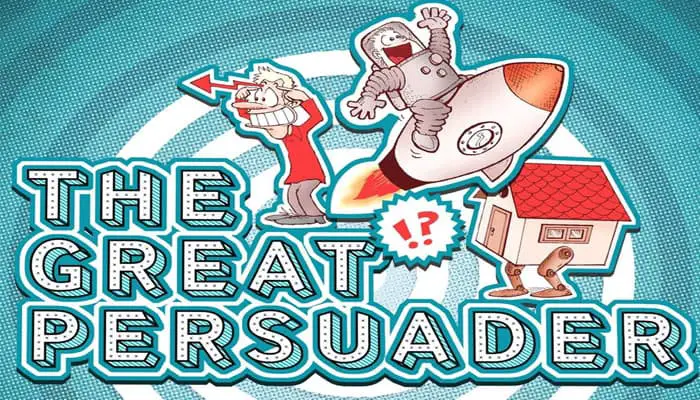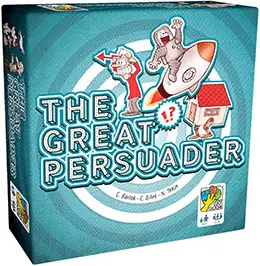
Components

- 110 cards (with blue and red sides)
- 8 voting tokens (front: heart; back: megaphone)
- 8 "Changed My Mind!" tiles
- 1 sand-timer
- 1 special die
- scoring pad and pencil
- Instructions
Object of the Game
Each turn of play, two players-the "Persuaders" - will try to convince another player-the "Customer" - either that their "bad" offer is good for him ("Working as a scarecrow has been the dream of your entire life!"), or that their good offer is not what he is looking for ("Why on earth would you want to win the lottery!?").
The Customer listens to both Persuaders and must choose one of them. In the meantime, all the other players bet on which one will prevail. Which player can be the most convincing?

Setup
Each player takes a voting token and a "Changed My Mind!" tile. Choose a starting player. That player is the first Customer: he takes the sand-timer and the special die.
The player to his left and the player on his right will be the first two Persuaders. Since the Persuaders do not get to vote, they lay their voting tokens in front of them: the left player with the megaphone showing and the right with the heart showing (this identifies them with one symbol).
The other players will vote for * one or the other using their voting tokens.

Shuffle the cards and you are ready to begin!
Game Play
The Customer rolls the special die. Each Persuader then draws 1 card and reads aloud the side that matches the result of the die roll.
Example: The Customer rolls red. Both Persuaders read the red side o f their cards.
Now, all of the other players (i.e., everyone except the Customer and Persuaders) must secretly vote for which Persuader they think will be chosen by the Customer.
To bet, use your voting token: Place it in front of you with your chosen vote up (either heart or megaphone), and cover it with your hand so the others can't see it. You can bet based on the supposed or confirmed ability of the Persuaders, the cards drawn, etc.
Once all bets have been placed, the Persuader to the right gives a speech:
Red Side: to illustrate to the Customer the advantages of his offer (and the disadvantages of the other Persuader's offer); or
Blue Side: to illustrate to the Customer the disadvantages of his offer (and the advantages of the other Persuader's offer).
The first Persuader can only speak for the length of the sand- timer: the Customer flips the sand-timer at the start of the speech and watches it. Once the sand-timer runs out, the second Persuader gets to do the same with his offer.
The persuaders can interact and interrupt each other: the only judge for the discussion is the Customer!
Once both speeches are over, the Customer must choose one of the two Persuaders. He can base his decision on the virtues of the offers, on the oratorical skills of the Persuaders, or his own tastes. Once he announces his choice, all bets are revealed.
The winning Persuader scores 2 points. All players who bet on him each score 1 point.
All scores are written down on the scoring pad.
Note: the Customer always chooses the Persuader who convinced him more. In the case of the red side, the persuaders illustrate the advantages of their offerings: when the Customer chooses a Persuader, it means he wants to take his offer.
In the case of the blue side, the Persuaders illustrate the disadvantages of their offer and the benefits of the other: when the Customer chooses a Persuader (who will score 2 points), he accepts the offer made by the other Persuader!
Example (Red Side): Alfred has drawn "Working as a Scarecrow" and Bobby drew "Walking Backwards For a Year". Alfred must explain why it's good to work as a scarecrow, rather than walking backwards for a year.
Once the sand-timer runs out, Bobby must explain the opposite. The Customer eventually decides that he would prefer to walk backwards for a year: he accepts Bobby's offer, and Bobby scores 2 points.
Example (Blue Side): Cathy has drawn "Winning a million-dollar lottery" and Daniel drew "Discovering the Fountain of Youth". Cathy explains why it's bad to win a million dollar lottery, and good to discover the Fountain of Youth Afterwards, Daniel explains the opposite.
The Customer eventually decides that he would prefer to win a million dollar lottery rather than discover the Fountain of Youth, and accepts Cathy's offer. Thus, Daniel is the chosen Persuader - and he scores the 2points.
Once a Persuader is chosen, the turn is over. The cards used are discarded back to the box.
The role of Customer moves one player clockwise (this means that the Persuader to the left is the next Customer, and his two neighbors will be the new Persuaders).

The "Changed My Mind!" Tile

Each player has one special "Changed My Mind!" tile that can be used once during the entire game. If a player uses his tile, it is discarded back to the box.
By playing the special tile, a player may change his bet once both speeches are over-but before the Customer declares which offer wins!
End of the Game
The game ends after a certain number of turns have been played, depending on the number of players:
- 3 or 4 Players: once each player has been Customer twice;
- 5 to 8 players: once each player has been Customer once.
The player with the most points at the end of the game is the winner! If there is a tie, all tied players win!
Special Rules for 3 Players
Skip the voting phase. Players only score points by being the winning Persuader.
Continue Reading
